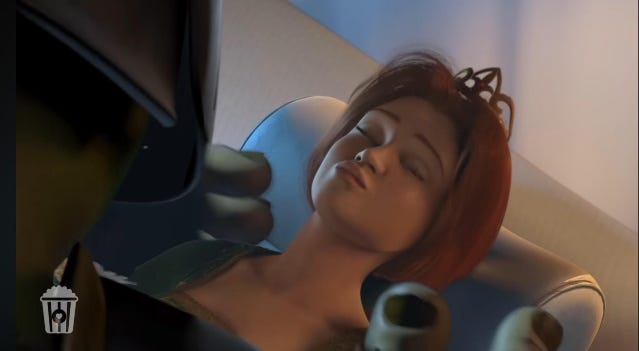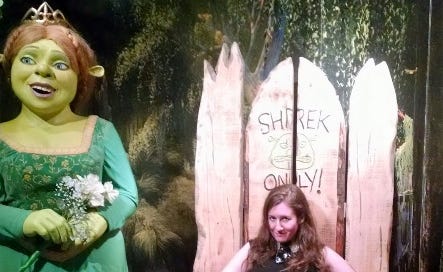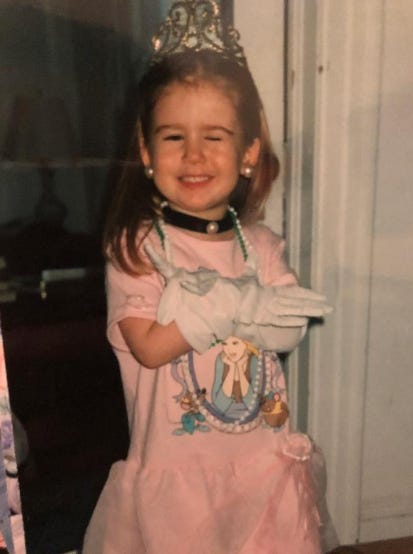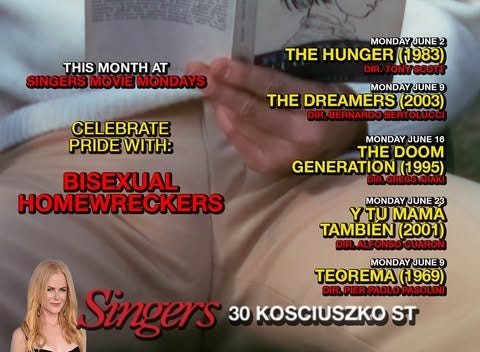Shrek versus CompHet: Fiona’s Character Journey as Related to a 30-Something’s Slow Self-Actualization
A guestie from a bestie!
Shrek versus CompHet: Fiona’s Character Journey as Related to a 30-Something’s Slow Self-Actualization
Shrek was released in May 2001; I saw it in theaters in June or July of that year and I thought it was fine. I watched it for the second time in August 2024, fresh off of being humiliated by an empty, insignificant person. The implosion of that situationship actually has nothing to do with this essay: At the time, I simply picked Shrek to watch with my best friend because I longed for whimsy, but I got more than I bargained for. I got recognition. I watched as the character of Fiona lived out all my mistakes of the 23 years between Shrek viewings. Our princess starts the series with unrealistic, rigid standards about “True Love”—namely, that it conquers all, as well as what it should look and act like. She even speaks stiltedly in her first scene - look it up on YouTube if you don’t believe me! She gradually realizes that these monarchical, patriarchal standards aren’t for her, and she outgrows her childish ideals, instead embracing her own personality and bonding with someone whose company she enjoys. Love isn’t ruled by beauty standards, and it isn’t a box so narrow that the confines of a complicated human personality could never fit. By the second film, Fiona is so self-actualized that she’s willing to choose herself, to choose her relationship—one that she forged out of honesty and empathy. The fairy tale ending is made possible by the most advanced stage of real-life human character development. I tease my friends that I’m looking for my own Shrek, I joke about wanting a Scottish-accented ogre, but the joke is on me if I only take that surface level relatability and don’t instead take the opportunity to be the best princess- ahem, human proletariat woman- that I can be.
This is where I would give a plot summary of Shrek and Shrek 2, but honestly, if you don’t know the broad strokes of what occurs in these films, are you living under a rock? Is Patrick Star your roommate? I kid, of course, but the films are iconic enough that we’ve all absorbed the plots like microplastics. I barely needed a refresher to write this, but I did keep replaying one scene from the first film: Fiona’s introductory scene as she’s being rescued. This is really when we first meet her, since her heavily curated Magic Mirror Tinder profile doesn’t count. Shrek crash-lands into her room, bursting through the ceiling like an aerial Kool Aid man. After the initial shock, she starts to pose, dressing up in the trappings of Damsel In Distress. She performs the highest level of femininity, completely objectifying herself as a sleeping princess needing to be kissed. She grabs a nearby bouquet of flowers, as if she didn’t already look lovely enough, smooths down her dress and puckers her lips in the hopes of getting the True Love’s Kiss right away.
Her predicament makes me think of a line from Taylor Swift’s “You’re On Your Own, Kid”: “…like I’d be saved by a perfect kiss.” If Fiona’s true love were a humanoid, non-ogre dude, she would have been “saved” by a perfect kiss, turning into the anti-magic, heteronormative patriarchal idea of a skinny white lady. Lucky for her it doesn’t work out that way, but we’re getting ahead of ourselves. The scene of Fiona trying to speed run True Love’s Kiss is me preparing to be picked up for a date; frantically showering, blow-drying my hair, throwing on makeup and then forcing myself to sit calmly on my couch until the object of my affection presses the buzzer, at which point I open the door casually, as if I hadn’t been agonizingly performing beauty labor. I pose on the threshold, pretending my anxiety isn’t obliterating me from within, confident that I have my own trappings of Damsel in Distress, Pretty Princess to comfort me as I face inevitable rejection. The process is the same in all circumstances of meeting prospective paramours; if I’m not being picked up at home, I’m splurging on a Lyft so that the wind doesn’t ruin my hair and makeup, and having a panic attack in the safety of a stranger’s car so that I can show up to a second location casually, as if I was a princess who was meant to be here. I know I’m not the only one who does this; we all have our version of pretending we’re not as desperate (I do not use that word derogatorily) as we are. For if I’m a beautiful and serene enough object, won’t I be loved?

Trapped in the tower of adolescence, especially isolated and/or bullied adolescence, storybook ideas of romance and gender roles take root and need time to be dislodged. This was me freshman year of high school, reading YA novels and using them as a basis of behavior, begging my parents to buy me designer clothes, talking at my classmates instead of to or with them, being so intent on presenting an idea of myself instead of figuring out who I was. I wish I had prioritized connection and indulged my natural curiosity about the people around me, but that’s another story, and I shouldn’t demonize my former self too much; she exists in context1. Back to Fiona: our green-clad lady learned early in the first movie that allowing yourself to feel empathy for the people around you, and cooking them breakfast, feels pretty good. Bonding with someone with whom you share mutual interests, even if said interests are tailored for a kid-friendly audience and therefore mostly involve burps and farts, is nice. She builds a real relationship with Shrek, and to a lesser extent honorary brother-in-law Donkey, that doesn’t involve speed-running True Love’s Kiss; they only kiss at the end of the movie, after the deadline, with the reveal that said kiss unlocked her true form. Free from the stilted table manners of her parents’ castle, making real friends for the first time, Fiona was free to cultivate her own personality. What if she had been able to stay in her human form forever—if she had been “saved by a perfect kiss”, “saved” as in the lies that the patriarchy and compulsory heterosexuality tells you? What parts of herself- and I don’t mean the “turns green after sunset” part- would she not have been able to reconcile with? What discoveries of her true personality would she have never unlocked? Most importantly, what can we learn from this: what freedoms do we discover when we’re not doing as we’re told? I shudder to think what I would be like if all of my fake personality antics were positively reinforced. What kind of empty shell would I be today if I had been appreciated back then for being what I wasn’t?
One of many weird things about Shrek is that its plot is structured like a cliched rom-com. I’m not the first person to point this out; one of my favorite unhinged YouTube videos, A Marxist Analysis of Shrek, states that at the end of the day, it’s not revolutionary to fall into the heteronormative hegemony. But I want to believe in revolutionary love, I want to believe that not settling for Lord Farquaad/Prince Charming is revolutionary in itself. After all, Dragon singlehandedly overthrows his Disneyland-esque tyranny at the request of her own unconventional romantic love, Donkey. And in Fiona’s case, sometimes the journey is internal, to embrace your gassy green persona and live a chill life with a community that vibes with the real you2. Fiona gets the husband that is her soulmate, but as for me, I don’t want to push partnership as the one-size-fits-all happy ending. I don’t want the takeaway from the Shrek films to be “Someday my prince will come, but the prince in this case is an ogre”. I want the takeaway to be: “embrace your inner ogre, whatever that means, and cut loose the societal ideals that don’t serve you.” I don’t have a great line of my own to end this spiel on, so I’ll go back to a song I quoted earlier—the quote was out of context and the real song itself is about prioritizing the agony and joys of self-discovery: You’re on your own, kid. You always have been.
lives in a garden shed off Central Park with her two cat children, Anita and Churro. She has a deep love of human beings and the art they make, which she sheepishly tries to write about. She is very lucky to be friends with Tara.Note from Tara: this is SO resonant. I have been so ardent this year in not throwing my younger, less healed me under the bus, writing her off as crazy when she was navigating undiagnosed CPTSD. Love this.
Tara noting: my gassy green persona is actually the only one Susannah knows and she likes it. Aww.













Eeeeee!!!! Also I hope the week in you was great!!!
I feel like part of the journey of self discovery is trying to fit into that “normal” box. And I’m genuinely so curious what it feels like to experience that “I fits, I sits” moment because, like you, I always felt unfulfilled with all of those standard expectations and struggled for years to “fit”. But you don’t know that you don’t fit until you try. So I guess I’m saying that we can’t blame Fiona (or anyone) for trying to go the classic route, because she had to learn for herself that it wasn’t right for her.